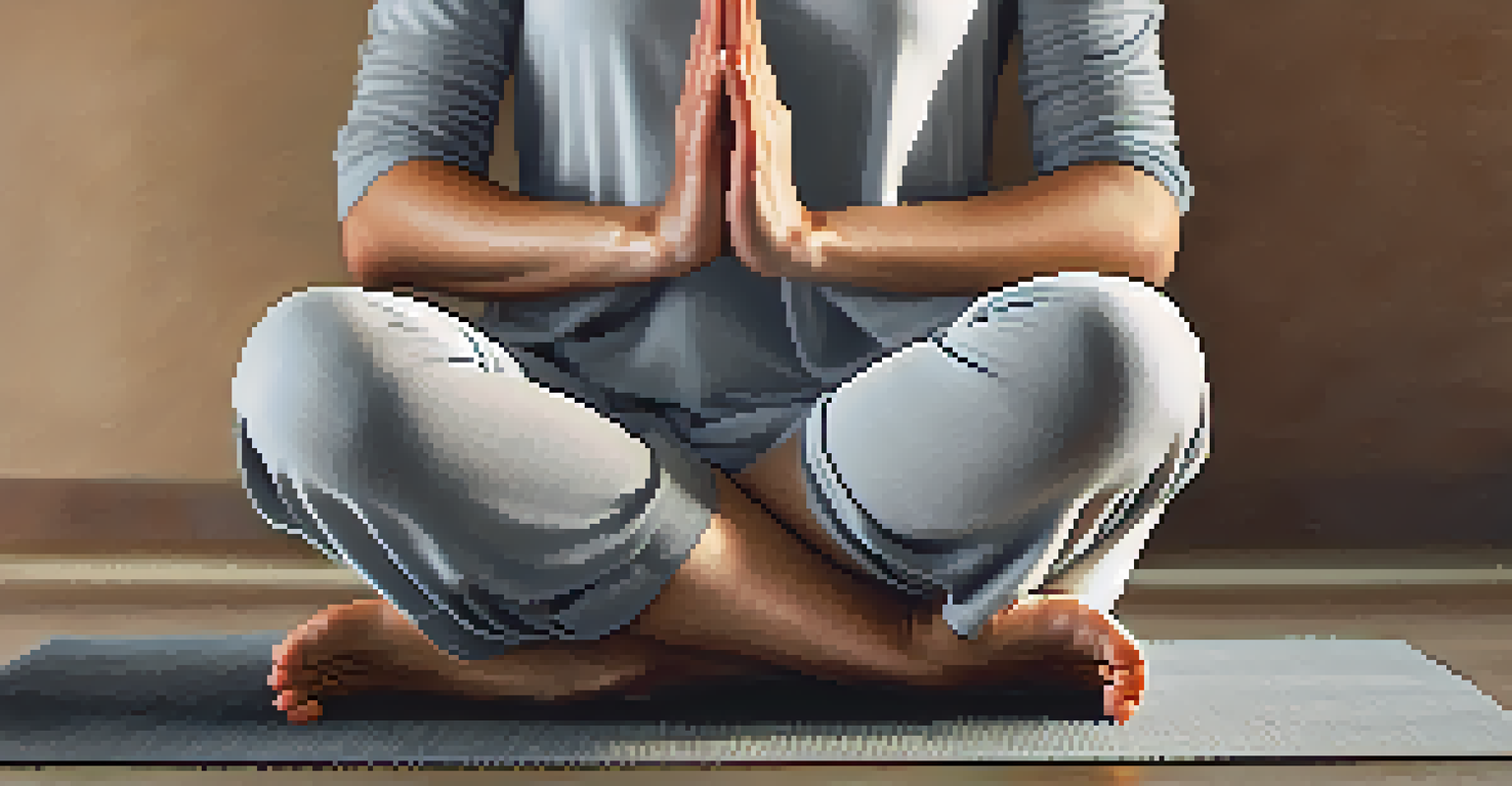Yoga for Beginners: Poses to Boost Flexibility and Balance

Understanding Yoga: A Gentle Introduction for Beginners
Yoga is a practice that combines physical postures, breathing exercises, and meditation. For beginners, it can seem intimidating, but it’s all about finding your own pace and comfort level. The beauty of yoga lies in its ability to cater to all ages and fitness levels, making it accessible for everyone.
Yoga is the journey of the self, through the self, to the self.
By incorporating yoga into your routine, you’ll not only enhance your flexibility and balance but also foster a sense of mindfulness. This holistic approach encourages you to connect with your body and breath, creating a calming effect that permeates your daily life. Remember, yoga is not just about the poses; it’s about the journey.
As you explore various poses, you’ll discover your body’s capabilities and limitations. This self-awareness is crucial for long-term growth and improvement. So, let’s dive into some essential yoga poses that will set you on the right path towards flexibility and balance.
The Importance of Flexibility in Your Yoga Practice
Flexibility is a key component of yoga that enhances your overall physical performance and reduces the risk of injury. When your muscles and joints are flexible, you’ll find it easier to move, engage in daily activities, and even perform other exercises. Think of flexibility as a way to keep your body youthful and agile.

As you stretch and lengthen your muscles through yoga poses, you’re promoting better circulation and improving your posture. This can lead to reduced tension and discomfort in your body. Moreover, increased flexibility can help with stress relief, allowing you to unwind and find peace in your practice.
Yoga Enhances Flexibility and Mindfulness
Incorporating yoga into your routine improves flexibility and fosters a sense of mindfulness that positively impacts daily life.
Incorporating flexibility-focused poses into your routine will gradually improve your range of motion. Over time, you’ll notice that your body feels more relaxed and resilient, making it easier to tackle life’s physical challenges. Now, let’s learn about some specific poses that can help boost your flexibility.
Balancing Your Body and Mind: Why Balance Matters
Balance is not just about standing on one foot; it's a vital skill that enhances stability, coordination, and body awareness. As you practice balance poses, you’ll strengthen the muscles that support your joints, leading to better overall physical health. Think of balance as the foundation of your yoga practice.
Inhale the future, exhale the past.
In addition to physical benefits, balance poses also promote mental concentration and focus. When you challenge your balance, you’re training your mind to stay present, which can be a valuable skill in everyday life. This mindfulness can help reduce anxiety and improve your overall well-being.
Developing balance takes time and patience, but with consistent practice, you'll notice significant improvements. Engaging in balance-focused yoga poses will not only enhance your physical stability but also empower you to tackle challenges with confidence. Let’s explore some foundational poses that will help you on this journey.
Essential Yoga Poses for Flexibility: Get Started
One of the best poses for improving flexibility is the 'Downward Facing Dog.' This pose stretches your hamstrings, calves, and spine while also engaging your arms and shoulders. To get into position, start on your hands and knees, then lift your hips up and back, creating an inverted V shape with your body.
Another excellent pose for flexibility is the 'Seated Forward Bend.' While seated, extend your legs in front of you and gently reach towards your toes. This pose deeply stretches the spine, hamstrings, and calves, promoting overall flexibility. Remember to breathe and go at your own pace.
Balance Strengthens Body and Mind
Practicing balance poses not only enhances physical stability but also promotes mental focus and reduces anxiety.
Finally, consider incorporating the 'Cobra Pose' into your routine. Lying on your stomach, place your hands under your shoulders and lift your chest while keeping your hips grounded. This pose opens your chest and stretches your abdominal muscles, contributing to better flexibility in your upper body.
Key Yoga Poses to Enhance Balance: Start Practicing
The 'Tree Pose' is a classic balance pose that is perfect for beginners. Stand tall and shift your weight onto one leg, then place the opposite foot on your inner thigh or calf (avoiding the knee). This pose not only improves balance but also encourages focus and stability.
Another beneficial balance pose is the 'Warrior III.' Begin in a standing position, then lean forward while lifting one leg behind you and extending your arms forward. This pose challenges your core and leg strength while enhancing your overall balance. It may take practice, but the results are worth it.
Lastly, the 'Half Moon Pose' is excellent for improving balance and flexibility simultaneously. Start in a standing position, then lean to one side, placing one hand on the floor while lifting the opposite leg and arm. This pose helps strengthen the legs and core while promoting a sense of equilibrium.
Breathing Techniques to Support Your Yoga Practice
Breathing is a fundamental aspect of yoga that can greatly enhance your practice. Also known as 'pranayama,' these breathing techniques help you connect with your body and mind. By focusing on your breath, you create a rhythm that allows you to flow through poses more smoothly.
A simple technique to start with is 'diaphragmatic breathing.' This involves inhaling deeply through your nose, allowing your diaphragm to expand, then exhaling slowly through your mouth. This type of breathing promotes relaxation and can help you stay centered during challenging poses.
Breathing Techniques Enhance Practice
Utilizing breathing techniques like diaphragmatic breathing helps connect your body and mind, creating a smoother flow during yoga.
As you become more comfortable with your practice, explore other breathing techniques like 'Ujjayi breath,' which involves slightly constricting the back of your throat while breathing. This creates a soothing sound and helps regulate your breath during yoga, enhancing your overall experience.
Tips for a Successful Yoga Journey as a Beginner
Starting your yoga journey can be both exciting and overwhelming. One of the best tips for beginners is to listen to your body. If a pose feels uncomfortable or painful, don’t hesitate to modify or skip it. Yoga is about self-discovery, and it’s perfectly okay to take things at your own pace.
Another essential tip is to create a dedicated space for your practice. Whether it’s a corner of your living room or a quiet spot outdoors, having a designated area can help you establish a routine. Surround yourself with calming elements like plants, candles, or soft music to enhance your experience.

Lastly, consider joining a beginner class or following online tutorials. This guidance can provide structure and support as you learn the basics of yoga. Remember, every expert was once a beginner, so be patient with yourself and enjoy the journey!